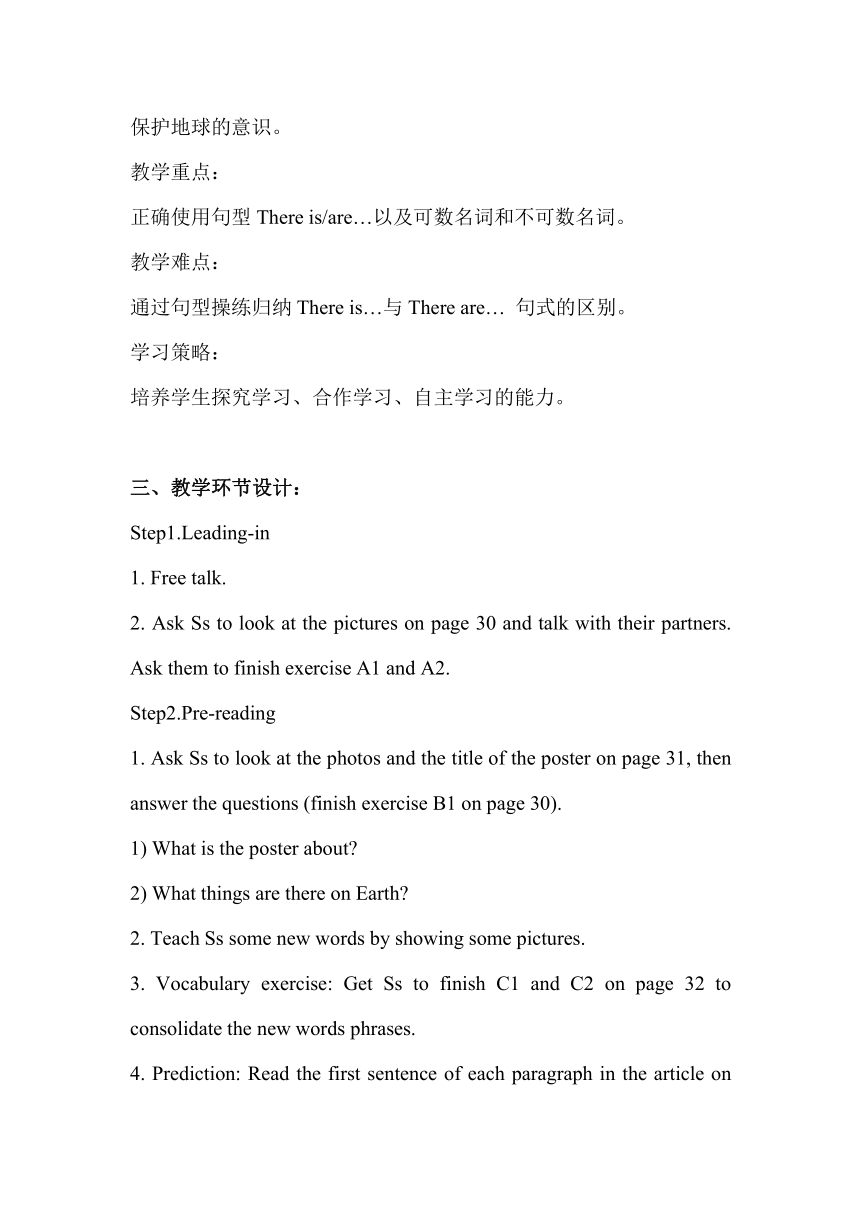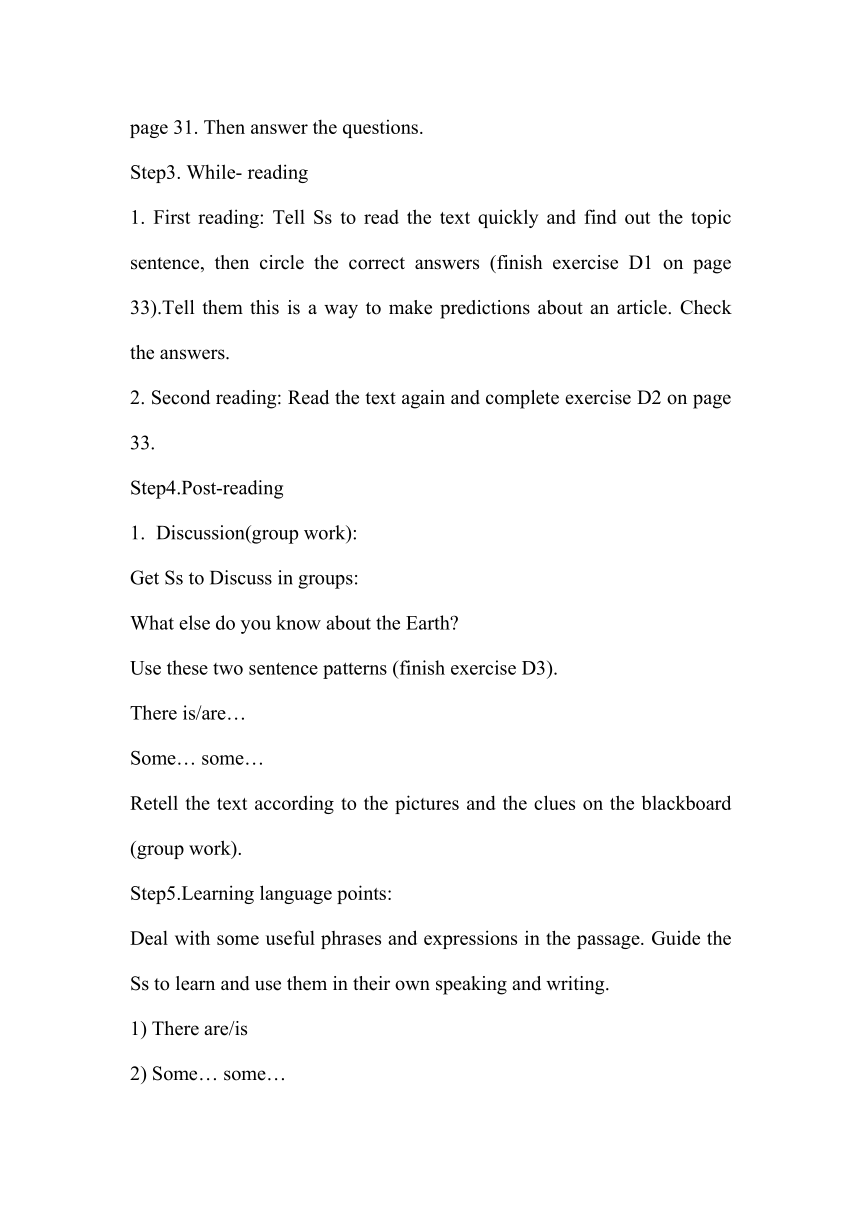Unit 3 The Earth 教案 (2)
文档属性
| 名称 | Unit 3 The Earth 教案 (2) |  | |
| 格式 | zip | ||
| 文件大小 | 13.1KB | ||
| 资源类型 | 教案 | ||
| 版本资源 | 牛津深圳版 | ||
| 科目 | 英语 | ||
| 更新时间 | 2016-09-29 18:11:41 | ||
图片预览



文档简介
Unit
3
The
Earth
教案
一、教学定位:
Input-based,
重视阅读理解。
Practice-based,
启发学生,归纳语言知识,开展多层次强化综合练习。
二、教学目标:
语言知识:
1.深入学习主阅读篇章的结构以及相关的语言点。
2.正确区分可数名词与不可数名词。
3.掌握句式There
is/are…的用法。认读和理解单词。
语言技能:
1.根据文本内容,寻找信息并完整表达。
2.学会可数名词与不可数名词的数量表达形式。
阅读要求:
1.通过多种形式的阅读活动与任务,帮助学生理解课文。
2.指导学生运用一定的阅读理解学习策略,培养一些阅读微技能,如:扫读,获取文章大意;通过构词法或上下文猜测生词大意;推断等。
3.指导学生了解以时间顺序为主的记叙文的结构。
4.拓展学生的文化背景知识,开阔视野。
情感态度:
了解地球上环境污染的现状,为减少环境污染尽自己的一份力,树立保护地球的意识。
教学重点:
正确使用句型There
is/are…以及可数名词和不可数名词。
教学难点:
通过句型操练归纳There
is…与There
are…
句式的区别。
学习策略:
培养学生探究学习、合作学习、自主学习的能力。
三、教学环节设计:
Step1.Leading-in
1.
Free
talk.
2.
Ask
Ss
to
look
at
the
pictures
on
page
30
and
talk
with
their
partners.
Ask
them
to
finish
exercise
A1
and
A2.
Step2.Pre-reading
1.
Ask
Ss
to
look
at
the
photos
and
the
title
of
the
poster
on
page
31,
then
answer
the
questions
(finish
exercise
B1
on
page
30).
1)
What
is
the
poster
about
2)
What
things
are
there
on
Earth
2.
Teach
Ss
some
new
words
by
showing
some
pictures.
3.
Vocabulary
exercise:
Get
Ss
to
finish
C1
and
C2
on
page
32
to
consolidate
the
new
words
phrases.
4.
Prediction:
Read
the
first
sentence
of
each
paragraph
in
the
article
on
page
31.
Then
answer
the
questions.
Step3.
While-
reading
1.
First
reading:
Tell
Ss
to
read
the
text
quickly
and
find
out
the
topic
sentence,
then
circle
the
correct
answers
(finish
exercise
D1
on
page
33).Tell
them
this
is
a
way
to
make
predictions
about
an
article.
Check
the
answers.
2.
Second
reading:
Read
the
text
again
and
complete
exercise
D2
on
page
33.
Step4.Post-reading
Discussion(group
work):
Get
Ss
to
Discuss
in
groups:
What
else
do
you
know
about
the
Earth
Use
these
two
sentence
patterns
(finish
exercise
D3).
There
is/are…
Some…
some…
Retell
the
text
according
to
the
pictures
and
the
clues
on
the
blackboard
(group
work).
Step5.Learning
language
points:
Deal
with
some
useful
phrases
and
expressions
in
the
passage.
Guide
the
Ss
to
learn
and
use
them
in
their
own
speaking
and
writing.
1)
There
are/is
2)
Some…
some…
3)provide
sb.
with
sth.
拓展:provide
sth.
for
sb.
4)put….into…
5)
It
is
+adj.+for
sb.
to
do
sth.(对某人来说做某事怎么样)
Step6.Grammar
Learning
---countable
and
uncountable
nouns
Presentation---ask
and
answer
about
the
pictures.
Eg1:
---What
do
you
see
on
the
table
Two
apples,
some
cakes,
two
bowls
of
rice,
two
cups
of
water…
2.
Summary---guide
the
students
to
summarize
the
following:
可数名词与不可数名词的意义
可数名词与不可数名词的用法
不可数名词的分类归纳
(可以小组竞赛形式)
Read
the
sentences
on
P35
and
work
out
the
rule.
3.
Exercise:
Get
Ss
to
finish
Exercise
A1.
Pair
work:
ask
and
answer
questions
about
each
photo
following
the
example:
finish
Exercise
A2.
Oral
practice:
Get
Ss
to
make
some
conversations
with
their
partners.
Get
Ss
to
learn
more
about
countable
and
uncountable
nouns.
Eg:
A
bottle
of
milk;
two
bottles
of
milk
Step7.
Presentation
of
“There
is/are”.
Explain
the
usage
of
“There
is/are”:
to
say
that
sth.
exists
in
swh.(某地有某物)
Ask
Ss
some
questions
according
to
the
picture.
Q:
What
are
there
on
the
table
A:
There
are
two
apples,
some
cakes,
two
bowls
of
rice
and
two
cups
of
water.
Get
Ss
to
work
out
the
rule:
finish
p37.
Get
Ss
to
pay
attention
to
“there
is”
or
“there
are”.
Eg:
There
is
a
glass
of
water
and
three
apples
on
the
table.
There
are
three
apples
and
a
glass
of
water
on
the
table.
Get
Ss
also
pay
attention
to:
there
is=there’s
There
is
not=
There
are
=
Get
Ss
to
finish
exercise
in
page
37.
Step8.Considalation
Translation
the
following
phrases:
一碗饭,两杯咖啡,三张纸,四盒鸡蛋,五个学生,六瓶酸奶,七双鞋子,一些食物。
2.
选词填空,使下列句子意思通顺:
a.
---Woo!
So
many
books
here!
---Could
you
help
me
carry
_______
books
to
_______
house
over
there
(this,
that,
these,
those)
b.
---Is
_______
bike
yours,
Miss
Chen
---No,
it
isn’t.
Can
you
see
the
one
under
the
tree
_______
is
mine.
(this,
that,
these,
those)
c.
__________
(How
many,
How
much)
money
do
we
need
for
the
project?
d.
There
is
__________
(too
few,
too
little)
oil.
You’d
better
buy
some
more.
Step4.
Summary
Get
Ss
to
summarize
what
they
have
learned
today.
Step9.
Homework
1.写出你最拿手的一道菜的食谱(所需材料与分量)(Optional:对于水平较好的学生,可要求他们写出烹调过程)。
2.分类归纳不可数名词(归纳本)。
3.完成练习册内相关练习。
3
The
Earth
教案
一、教学定位:
Input-based,
重视阅读理解。
Practice-based,
启发学生,归纳语言知识,开展多层次强化综合练习。
二、教学目标:
语言知识:
1.深入学习主阅读篇章的结构以及相关的语言点。
2.正确区分可数名词与不可数名词。
3.掌握句式There
is/are…的用法。认读和理解单词。
语言技能:
1.根据文本内容,寻找信息并完整表达。
2.学会可数名词与不可数名词的数量表达形式。
阅读要求:
1.通过多种形式的阅读活动与任务,帮助学生理解课文。
2.指导学生运用一定的阅读理解学习策略,培养一些阅读微技能,如:扫读,获取文章大意;通过构词法或上下文猜测生词大意;推断等。
3.指导学生了解以时间顺序为主的记叙文的结构。
4.拓展学生的文化背景知识,开阔视野。
情感态度:
了解地球上环境污染的现状,为减少环境污染尽自己的一份力,树立保护地球的意识。
教学重点:
正确使用句型There
is/are…以及可数名词和不可数名词。
教学难点:
通过句型操练归纳There
is…与There
are…
句式的区别。
学习策略:
培养学生探究学习、合作学习、自主学习的能力。
三、教学环节设计:
Step1.Leading-in
1.
Free
talk.
2.
Ask
Ss
to
look
at
the
pictures
on
page
30
and
talk
with
their
partners.
Ask
them
to
finish
exercise
A1
and
A2.
Step2.Pre-reading
1.
Ask
Ss
to
look
at
the
photos
and
the
title
of
the
poster
on
page
31,
then
answer
the
questions
(finish
exercise
B1
on
page
30).
1)
What
is
the
poster
about
2)
What
things
are
there
on
Earth
2.
Teach
Ss
some
new
words
by
showing
some
pictures.
3.
Vocabulary
exercise:
Get
Ss
to
finish
C1
and
C2
on
page
32
to
consolidate
the
new
words
phrases.
4.
Prediction:
Read
the
first
sentence
of
each
paragraph
in
the
article
on
page
31.
Then
answer
the
questions.
Step3.
While-
reading
1.
First
reading:
Tell
Ss
to
read
the
text
quickly
and
find
out
the
topic
sentence,
then
circle
the
correct
answers
(finish
exercise
D1
on
page
33).Tell
them
this
is
a
way
to
make
predictions
about
an
article.
Check
the
answers.
2.
Second
reading:
Read
the
text
again
and
complete
exercise
D2
on
page
33.
Step4.Post-reading
Discussion(group
work):
Get
Ss
to
Discuss
in
groups:
What
else
do
you
know
about
the
Earth
Use
these
two
sentence
patterns
(finish
exercise
D3).
There
is/are…
Some…
some…
Retell
the
text
according
to
the
pictures
and
the
clues
on
the
blackboard
(group
work).
Step5.Learning
language
points:
Deal
with
some
useful
phrases
and
expressions
in
the
passage.
Guide
the
Ss
to
learn
and
use
them
in
their
own
speaking
and
writing.
1)
There
are/is
2)
Some…
some…
3)provide
sb.
with
sth.
拓展:provide
sth.
for
sb.
4)put….into…
5)
It
is
+adj.+for
sb.
to
do
sth.(对某人来说做某事怎么样)
Step6.Grammar
Learning
---countable
and
uncountable
nouns
Presentation---ask
and
answer
about
the
pictures.
Eg1:
---What
do
you
see
on
the
table
Two
apples,
some
cakes,
two
bowls
of
rice,
two
cups
of
water…
2.
Summary---guide
the
students
to
summarize
the
following:
可数名词与不可数名词的意义
可数名词与不可数名词的用法
不可数名词的分类归纳
(可以小组竞赛形式)
Read
the
sentences
on
P35
and
work
out
the
rule.
3.
Exercise:
Get
Ss
to
finish
Exercise
A1.
Pair
work:
ask
and
answer
questions
about
each
photo
following
the
example:
finish
Exercise
A2.
Oral
practice:
Get
Ss
to
make
some
conversations
with
their
partners.
Get
Ss
to
learn
more
about
countable
and
uncountable
nouns.
Eg:
A
bottle
of
milk;
two
bottles
of
milk
Step7.
Presentation
of
“There
is/are”.
Explain
the
usage
of
“There
is/are”:
to
say
that
sth.
exists
in
swh.(某地有某物)
Ask
Ss
some
questions
according
to
the
picture.
Q:
What
are
there
on
the
table
A:
There
are
two
apples,
some
cakes,
two
bowls
of
rice
and
two
cups
of
water.
Get
Ss
to
work
out
the
rule:
finish
p37.
Get
Ss
to
pay
attention
to
“there
is”
or
“there
are”.
Eg:
There
is
a
glass
of
water
and
three
apples
on
the
table.
There
are
three
apples
and
a
glass
of
water
on
the
table.
Get
Ss
also
pay
attention
to:
there
is=there’s
There
is
not=
There
are
=
Get
Ss
to
finish
exercise
in
page
37.
Step8.Considalation
Translation
the
following
phrases:
一碗饭,两杯咖啡,三张纸,四盒鸡蛋,五个学生,六瓶酸奶,七双鞋子,一些食物。
2.
选词填空,使下列句子意思通顺:
a.
---Woo!
So
many
books
here!
---Could
you
help
me
carry
_______
books
to
_______
house
over
there
(this,
that,
these,
those)
b.
---Is
_______
bike
yours,
Miss
Chen
---No,
it
isn’t.
Can
you
see
the
one
under
the
tree
_______
is
mine.
(this,
that,
these,
those)
c.
__________
(How
many,
How
much)
money
do
we
need
for
the
project?
d.
There
is
__________
(too
few,
too
little)
oil.
You’d
better
buy
some
more.
Step4.
Summary
Get
Ss
to
summarize
what
they
have
learned
today.
Step9.
Homework
1.写出你最拿手的一道菜的食谱(所需材料与分量)(Optional:对于水平较好的学生,可要求他们写出烹调过程)。
2.分类归纳不可数名词(归纳本)。
3.完成练习册内相关练习。
